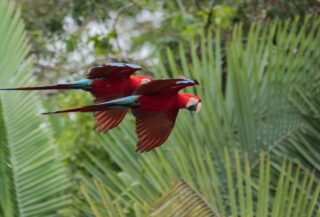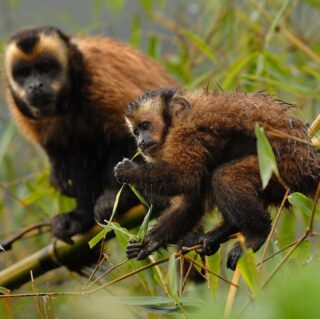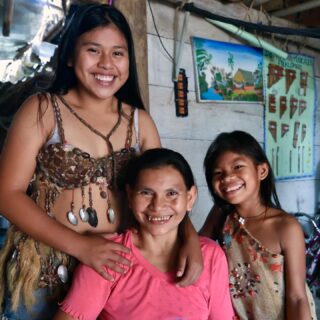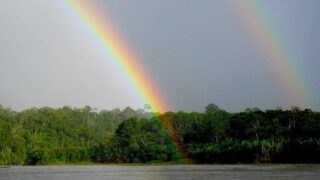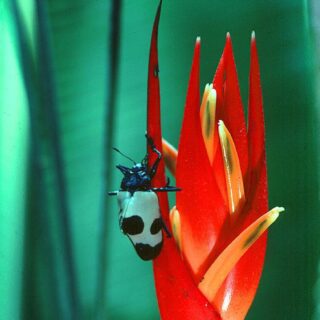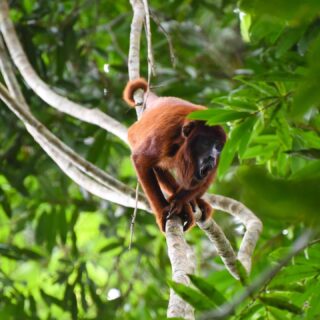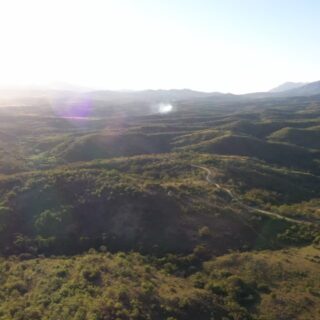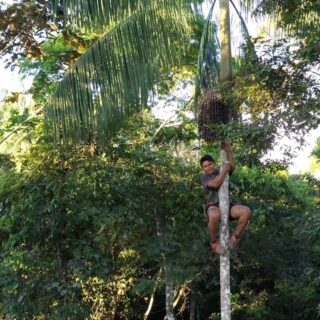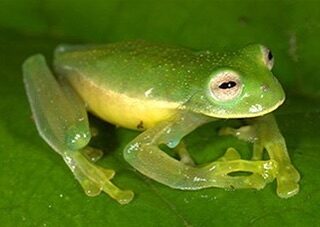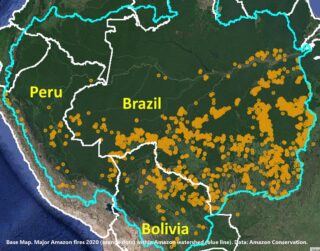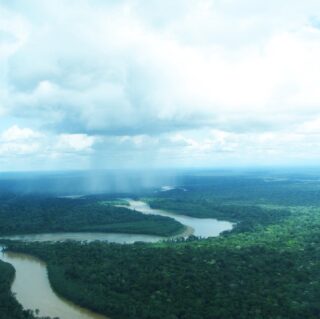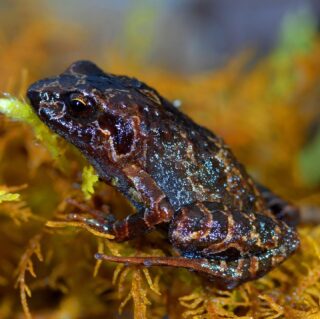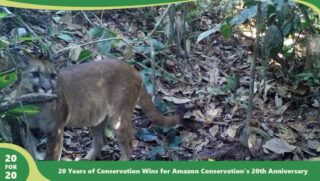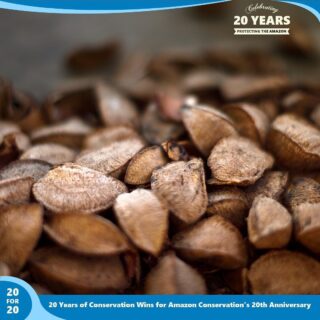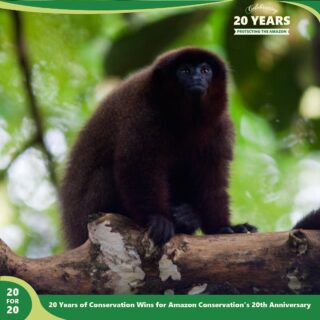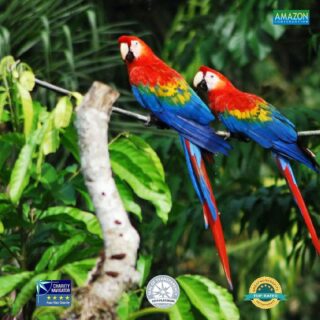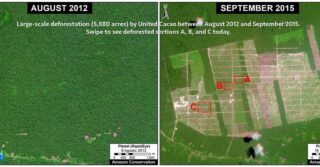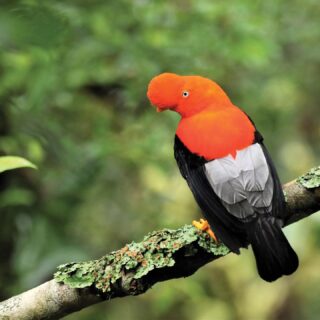 The Manu-Tambopata Corridor Initiative (MAT) was launched in February 2009 to conserve one of the most important biodiversity hotspots in the world, a 519,000 acre (210,000 hectare) area of rainforest in the Peruvian Amazon. This initiative is the centerpiece of ACA’s efforts to lessen the environmental impacts of the Interoceanic Highway, a transcontinental road that models predict could produce a swath of deforestation the size of Massachusetts and Connecticut combined.
The Manu-Tambopata Corridor Initiative (MAT) was launched in February 2009 to conserve one of the most important biodiversity hotspots in the world, a 519,000 acre (210,000 hectare) area of rainforest in the Peruvian Amazon. This initiative is the centerpiece of ACA’s efforts to lessen the environmental impacts of the Interoceanic Highway, a transcontinental road that models predict could produce a swath of deforestation the size of Massachusetts and Connecticut combined.
The Interoceanic Highway is expected to be completed by 2011 and runs across the South American continent from Rio de Janeiro, Brazil on the Atlantic Ocean to the Pacific Ocean ports of Peru. This expanse of paved highway threatens to create a band of deforestation of up to 62 miles (100km) across. Rampant deforestation in this region would likely change the weather patterns in the Amazon and emit millions of tons of carbon dioxide, a major greenhouse gas that contributes to climate change.
 Establishing the Manu-Tambopata Corridor will protect the area between the Los Amigos Conservation Concession and the Tambopata reserve. At the same time, it will conserve the last unprotected stretch at the heart of the Vilcabamba-Amboró Mega Corridor, which connects 16 protected areas from Peru to Bolivia in a chain of pristine tropical rainforest and pampa ecosystems. The region is home to an incredible abundance of plants and animals, including giant river otters, jaguars, scarlet macaws, spider monkeys, and wild vanilla trees among others. The MAT will connect world-famous Manu National Park to the Tambopata National Reserve by way of ACA’s Los Amigos Conservation Concession.
Establishing the Manu-Tambopata Corridor will protect the area between the Los Amigos Conservation Concession and the Tambopata reserve. At the same time, it will conserve the last unprotected stretch at the heart of the Vilcabamba-Amboró Mega Corridor, which connects 16 protected areas from Peru to Bolivia in a chain of pristine tropical rainforest and pampa ecosystems. The region is home to an incredible abundance of plants and animals, including giant river otters, jaguars, scarlet macaws, spider monkeys, and wild vanilla trees among others. The MAT will connect world-famous Manu National Park to the Tambopata National Reserve by way of ACA’s Los Amigos Conservation Concession.
The objective of the MAT Corridor Initiative is to protect forest cover and ecological connectivity while creating sustainable economic and social benefits for local communities. ACA will work with rural families and regional policy makers to introduce a mosaic of conservation areas and sustainable land management practices that can make a profit, such as agroforestry, ecotourism, extraction of non-timber forest products, and carbon finance. The MAT initiative will promote these conservation-based industries as a substitute for predatory land uses that threaten to destroy the rainforest, such as logging, large-scale agriculture, cattle ranching and slash-and-burn farming. Stay tuned for updates as these exciting projects develop!

 The Andean region’s smallest known frog was recently discovered in the cloud forest near Peru’s Manu National Park. Over the past two years, 10 new frog species have been found in the forest around ACA’s
The Andean region’s smallest known frog was recently discovered in the cloud forest near Peru’s Manu National Park. Over the past two years, 10 new frog species have been found in the forest around ACA’s  studying at Wayqecha because it contradicts the informal rule that high altitude vertebrates tend to be larger than low altitude vertebrates. Noble’s pygmy frog is among the smallest vertebrates ever found at this altitude, and one of the smallest amphibian species in the world.
studying at Wayqecha because it contradicts the informal rule that high altitude vertebrates tend to be larger than low altitude vertebrates. Noble’s pygmy frog is among the smallest vertebrates ever found at this altitude, and one of the smallest amphibian species in the world. The end of 2008 has been a time of change for ACA. In our most recent news, we would like to say goodbye to Dr. Nigel Pitman, ACA’s Science Director, who is moving to Brazil. We at ACA want to express our gratitude to Nigel, who has led the charge for strong and innovative science in all ACA’s programs.
The end of 2008 has been a time of change for ACA. In our most recent news, we would like to say goodbye to Dr. Nigel Pitman, ACA’s Science Director, who is moving to Brazil. We at ACA want to express our gratitude to Nigel, who has led the charge for strong and innovative science in all ACA’s programs. ACA has been working hard to ensure that students living near Manu National Park learn how to protect the majestic cloud forest in their back yard. The cloud forests where the eastern slopes of the Andes meet the Amazonian lowlands constitute one of the world’s greatest conservation priorities, and with the support of the Sea World & Busch Gardens Conservation Fund, we’re doing our best to protect this area.
ACA has been working hard to ensure that students living near Manu National Park learn how to protect the majestic cloud forest in their back yard. The cloud forests where the eastern slopes of the Andes meet the Amazonian lowlands constitute one of the world’s greatest conservation priorities, and with the support of the Sea World & Busch Gardens Conservation Fund, we’re doing our best to protect this area. Over 300 students submitted
Over 300 students submitted  In October 2008, ACA embarked on the final stage of our project to map all the Brazil nut stands in the northern territory of the indigenous Tacana. The tree census in the Bolivian Amazon is intended to support the Tacana petition for government recognition of their territorial land claim, known as a TCO in Bolivia.
In October 2008, ACA embarked on the final stage of our project to map all the Brazil nut stands in the northern territory of the indigenous Tacana. The tree census in the Bolivian Amazon is intended to support the Tacana petition for government recognition of their territorial land claim, known as a TCO in Bolivia. Scientists are from Mars and artists are from Venus—right? Not at Los Amigos! This year our flagship station, normally overrun by scientist types, threw open its doors to the right side of the brain via a new resident artist program. Frances Buerkens, a student at Berea College, was our first artist. She spent two months at Los Amigos taking photographs of Amazonian wildlife, people and landscapes. One of her photos, reproduced above in the article on mercury contamination, was published in New Scientist with an article on the devastating effects of mining in tropical forests.
Scientists are from Mars and artists are from Venus—right? Not at Los Amigos! This year our flagship station, normally overrun by scientist types, threw open its doors to the right side of the brain via a new resident artist program. Frances Buerkens, a student at Berea College, was our first artist. She spent two months at Los Amigos taking photographs of Amazonian wildlife, people and landscapes. One of her photos, reproduced above in the article on mercury contamination, was published in New Scientist with an article on the devastating effects of mining in tropical forests. Gold mining in the Amazon can devastate riverside forests and human health. Artisanal gold miners, often from poor migrant communities, are lured to Madre de Dios, Peru by the dream of easy riches. The state is the most active alluvial gold mining region in Peru, producing between 50 and 100 tons of gold annually.
Gold mining in the Amazon can devastate riverside forests and human health. Artisanal gold miners, often from poor migrant communities, are lured to Madre de Dios, Peru by the dream of easy riches. The state is the most active alluvial gold mining region in Peru, producing between 50 and 100 tons of gold annually. Over the last year, ACA has partnered with the US Environmental Protection Agency (EPA) to produce new scientific data about mining-related mercury emissions in Madre de Dios and their impact on human health. In December 2007, USAID invited ACA to participate in a meeting with the EPA concerning mercury contamination, and a partnership was born. In May, ACA hosted EPA researchers at our project office in Puerto Maldonado, led tours of mining communities and gold shops, and introduced the EPA team to regional government representatives. On field trips, EPA researchers measured mercury levels that far exceeded any they had encountered at their other project sites, in countries as diverse as Brazil and Senegal. In the fall, the EPA team returned at the invitation of Madre de Dios regional government to install a pilot mercury-capture device that reduced mercury emissions from the amalgamation process by 90%.
Over the last year, ACA has partnered with the US Environmental Protection Agency (EPA) to produce new scientific data about mining-related mercury emissions in Madre de Dios and their impact on human health. In December 2007, USAID invited ACA to participate in a meeting with the EPA concerning mercury contamination, and a partnership was born. In May, ACA hosted EPA researchers at our project office in Puerto Maldonado, led tours of mining communities and gold shops, and introduced the EPA team to regional government representatives. On field trips, EPA researchers measured mercury levels that far exceeded any they had encountered at their other project sites, in countries as diverse as Brazil and Senegal. In the fall, the EPA team returned at the invitation of Madre de Dios regional government to install a pilot mercury-capture device that reduced mercury emissions from the amalgamation process by 90%. Cesar Moran-Cahusac began as ACA’s Executive Director in August 2007. Born in Lima, Peru, Cesar has worked on a wide spectrum of conservation projects.
Cesar Moran-Cahusac began as ACA’s Executive Director in August 2007. Born in Lima, Peru, Cesar has worked on a wide spectrum of conservation projects. Converting muddy-boots field work to high-quality research takes years of hard work, but it’s beginning to pay off for our young research program in the Amazon. In the first six months of 2008 alone, work done at the Los Amigos Biologi
Converting muddy-boots field work to high-quality research takes years of hard work, but it’s beginning to pay off for our young research program in the Amazon. In the first six months of 2008 alone, work done at the Los Amigos Biologi cal Station (CICRA, its Spanish acronym) generated 11 peer-reviewed articles, two Ph.D. dissertations, and half a dozen theses by Peruvian undergraduates.
cal Station (CICRA, its Spanish acronym) generated 11 peer-reviewed articles, two Ph.D. dissertations, and half a dozen theses by Peruvian undergraduates. As the Interoceanic Highway is paved across highly biodiverse southeastern Peru, it is expected that forest loss will increase dramatically. Road improvement in the Amazon is typically associated with increased rates of deforestation, colonization, illegal logging, and land clearing for farming, artisanal gold mining, and cattle ranching. These practices spread through the construction of illegal secondary roads and increased in-migration. By some estimates, the paving could result in a 60 mile-wide swath of deforestation between Manu National Park and Tambopata National Reserve.
As the Interoceanic Highway is paved across highly biodiverse southeastern Peru, it is expected that forest loss will increase dramatically. Road improvement in the Amazon is typically associated with increased rates of deforestation, colonization, illegal logging, and land clearing for farming, artisanal gold mining, and cattle ranching. These practices spread through the construction of illegal secondary roads and increased in-migration. By some estimates, the paving could result in a 60 mile-wide swath of deforestation between Manu National Park and Tambopata National Reserve.
